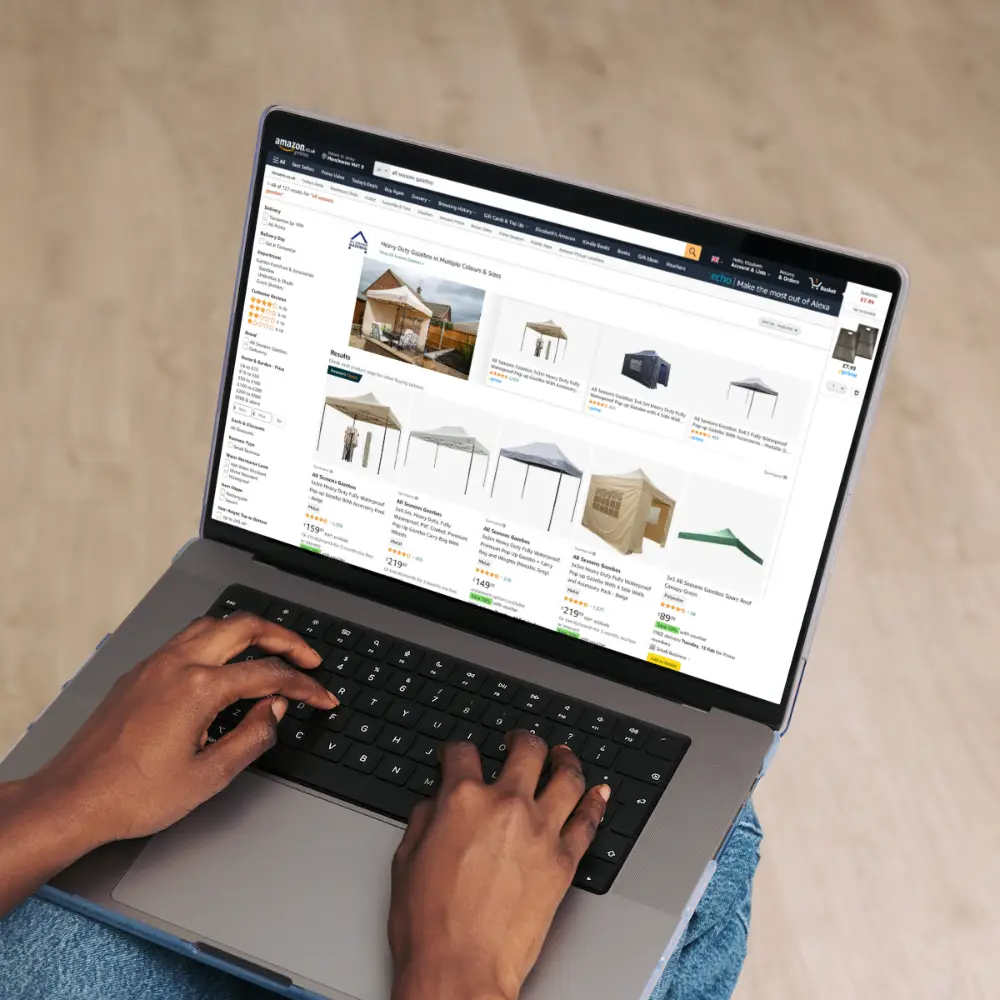One of the most common questions we hear from both vendors and sellers alike is how can they improve their Buy Box win rates?
Many believe that it is simply a race to the bottom, but it’s not quite that straightforward. Once you’ve gained an understanding of how the Buy Box works and what factors contribute to high win rates you can begin to take steps that will give your products an edge over competitors, even on the most competitive listings.
What Is the Buy Box?
The Buy Box is shown to the right of the product on desktop or directly beneath the product in the Amazon Shopping app. It’s where a customer will take any purchasing actions like adding to cart, 1-Click Purchasing or comparing all the available offers.
It shows the price, stock status, who is selling and dispatching the product, expected delivery times and of course the ‘Add to Cart’ and ‘Buy Now’ buttons. When there are multiple sellers for a product, they are ranked and whoever comes out on top will ‘win’ the Buy Box. This means that should a user add to cart or purchase directly from the Buy Box, they will be ordering from the Buy Box winner.
Users have the option to compare offers from other sellers and buy from them, however this is only available through a small, somewhat downplayed link right at the bottom of the Buy Box.
Why Do You Want to Win It?
The obvious reason to win the Buy Box is that in the vast majority of cases the customer will be buying from the Buy Box winner, so you want that to be you.
For a seller, the main consideration is simply revenue. If the product is a best seller but not being bought from you, you’re missing out. For the vendor however, you must additionally consider that if Amazon cannot consistently win the Buy Box with your product they will drop the price until they do, or put it on the CRaP list (Can’t Realise any Profit) and stop placing PO’s for it.
Importantly, if you are running Sponsored Product ads, they can only be run for products that you are currently in the Buy Box for. This is both good and bad. Good because you won’t be paying for traffic to a product that someone else will receive the order for. Bad because you miss out on using a valuable tool for driving traffic and sales, especially if it’s a product that you are seeking growth from.
What Are the Considerations in Winning the Buy Box?
Price is the headline attribute when it comes to winning the Buy Box, and is heavily weighted in determining who the Buy Box winner is. This is especially evident in the Buy Box winning strategy that Amazon employs for products they own the inventory for. Their price leadership policy effectively means that they will drop the price until they are firmly in the buy box. While offering the best price might be the fast track option, it’s not the only factor considered.
Price: Often the most competitive offer will win the buy box. Sellers have complete control over how they price their products, whereas Amazon sets the prices for a vendor’s products.
Delivery Options: Ideally fast and free. FBA (Fulfilment By Amazon) is the preferred option in terms of high Buy Box win rates and it also makes your products Prime eligible.
In Stock: Naturally you must have it in stock in order to sell it, however how consistently you maintain healthy stock levels is considered.
Seller Metrics: Areas of account performance such as Order Defect Rate, Late Dispatch Rate and Pre-Fulfilment Cancellation Rate are also considered. Using FBA or being a vendor will take care of a lot of this, but if you’re responsible for these then you must adhere to Amazon’s targets, which are quite strict.
Customer Feedback: If you have a good number of positive seller reviews this will benefit you, conversely if the opposite is true then it will damage your Buy Box win rates.
How To Improve Your Buy Box Win Rate
Price: There are separate considerations here for sellers and vendors. Sellers can set their prices independently, so can monitor competitors to maintain good prices as well as make use of dynamic repricing tools to keep their offer in the Buy Box.
Vendors have their prices set by Amazon, so inherently have less control in this area. In order to enable Amazon to keep pricing competitive you may have to make concessions in the prices at which you sell to Amazon.
This is a contentious point as often vendor negotiations with Amazon centre more around trying to get the highest selling price agreed in order to protect your margins. In the case where the product sells in high volumes and your margins are healthy though, you might consider giving them a better deal if Buy Box win rates are declining.
Delivery Options: The optimal choice is either Fulfilment By Amazon, or the newer Seller Fulfilled Prime, in which you still handle delivery but in a way that mimics FBA from the customer’s perspective and allows your products to be Prime eligible.
If all of your main competitors are using FBA that’s a reasonably good indicator that it’s the benchmark for that product, however for larger products it may not be necessary as the storage and delivery costs may be too high for FBA, meaning other sellers will also be fulfilling orders themselves.
Stock Status: Much like pricing there are separate considerations for sellers and vendors. Sellers should monitor sales volumes comparative to stock levels and ensure they are being replenished to avoid going out of stock on a product.
Vendor’s stock levels are determined by the PO’s they receive from Amazon, so ensuring they are fulfilled correctly and completely is naturally of high importance. However, if you feel some of your products are going out of stock too frequently or for too long you should discuss it with your vendor manager.
Seller Metrics: If you are a vendor or a seller exclusively using FBA this will largely be taken care of for you. Maintaining a watertight order management system is imperative to keeping your seller metrics healthy. You should ensure orders are processed and dispatched rapidly, as well as any returns or buyer queries handled effectively. This is especially important if you’re a newer seller without a large volume of sales, as only one or two issues can immediately take you out of the running for any Buy Box should your order defect rate rise above 1%.
The Golden Buy Box
While very specifically considering the various factors that contribute to your Buy Box win rates is important, it’s equally important to not lose sight of the purpose of the Buy Box, which underpins the entire attraction of Amazon as a place to shop. Amazon want you, the merchant, to provide customers with a best-in-class buying experience. This means offering a quality product at a competitive price, delivering on time, and with the assurance that they will be looked after should something go wrong.
Want to find out more? Get in touch with our Amazon team here.


